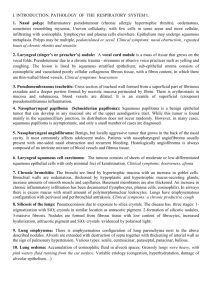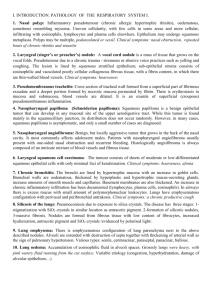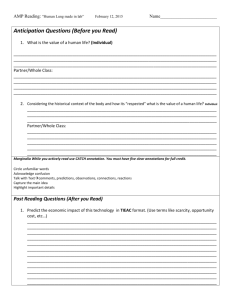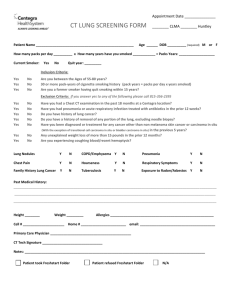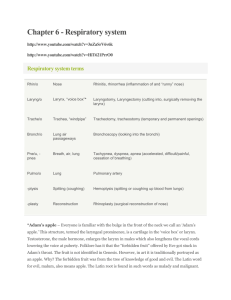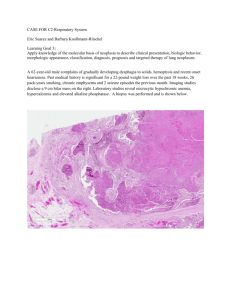I. PRACTICAL CLASSES – DENTISTRY WS Pathology of the
advertisement
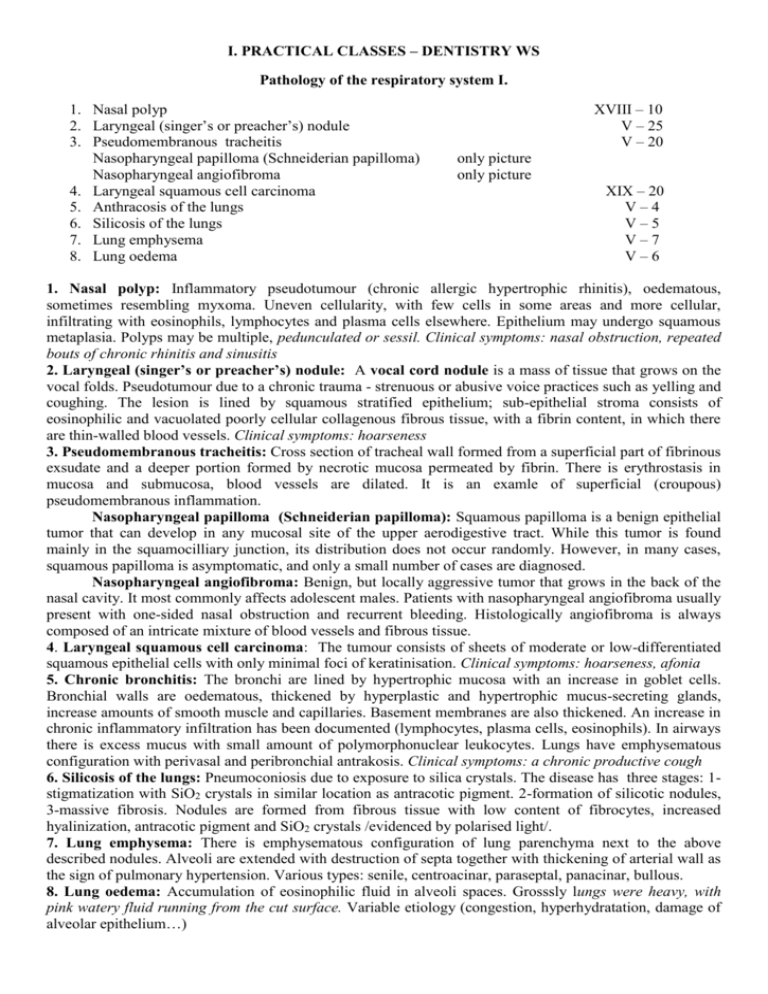
I. PRACTICAL CLASSES – DENTISTRY WS Pathology of the respiratory system I. 1. Nasal polyp 2. Laryngeal (singer’s or preacher’s) nodule 3. Pseudomembranous tracheitis Nasopharyngeal papilloma (Schneiderian papilloma) Nasopharyngeal angiofibroma 4. Laryngeal squamous cell carcinoma 5. Anthracosis of the lungs 6. Silicosis of the lungs 7. Lung emphysema 8. Lung oedema XVIII – 10 V – 25 V – 20 only picture only picture XIX – 20 V–4 V–5 V–7 V–6 1. Nasal polyp: Inflammatory pseudotumour (chronic allergic hypertrophic rhinitis), oedematous, sometimes resembling myxoma. Uneven cellularity, with few cells in some areas and more cellular, infiltrating with eosinophils, lymphocytes and plasma cells elsewhere. Epithelium may undergo squamous metaplasia. Polyps may be multiple, pedunculated or sessil. Clinical symptoms: nasal obstruction, repeated bouts of chronic rhinitis and sinusitis 2. Laryngeal (singer’s or preacher’s) nodule: A vocal cord nodule is a mass of tissue that grows on the vocal folds. Pseudotumour due to a chronic trauma - strenuous or abusive voice practices such as yelling and coughing. The lesion is lined by squamous stratified epithelium; sub-epithelial stroma consists of eosinophilic and vacuolated poorly cellular collagenous fibrous tissue, with a fibrin content, in which there are thin-walled blood vessels. Clinical symptoms: hoarseness 3. Pseudomembranous tracheitis: Cross section of tracheal wall formed from a superficial part of fibrinous exsudate and a deeper portion formed by necrotic mucosa permeated by fibrin. There is erythrostasis in mucosa and submucosa, blood vessels are dilated. It is an examle of superficial (croupous) pseudomembranous inflammation. Nasopharyngeal papilloma (Schneiderian papilloma): Squamous papilloma is a benign epithelial tumor that can develop in any mucosal site of the upper aerodigestive tract. While this tumor is found mainly in the squamocilliary junction, its distribution does not occur randomly. However, in many cases, squamous papilloma is asymptomatic, and only a small number of cases are diagnosed. Nasopharyngeal angiofibroma: Benign, but locally aggressive tumor that grows in the back of the nasal cavity. It most commonly affects adolescent males. Patients with nasopharyngeal angiofibroma usually present with one-sided nasal obstruction and recurrent bleeding. Histologically angiofibroma is always composed of an intricate mixture of blood vessels and fibrous tissue. 4. Laryngeal squamous cell carcinoma: The tumour consists of sheets of moderate or low-differentiated squamous epithelial cells with only minimal foci of keratinisation. Clinical symptoms: hoarseness, afonia 5. Chronic bronchitis: The bronchi are lined by hypertrophic mucosa with an increase in goblet cells. Bronchial walls are oedematous, thickened by hyperplastic and hypertrophic mucus-secreting glands, increase amounts of smooth muscle and capillaries. Basement membranes are also thickened. An increase in chronic inflammatory infiltration has been documented (lymphocytes, plasma cells, eosinophils). In airways there is excess mucus with small amount of polymorphonuclear leukocytes. Lungs have emphysematous configuration with perivasal and peribronchial antrakosis. Clinical symptoms: a chronic productive cough 6. Silicosis of the lungs: Pneumoconiosis due to exposure to silica crystals. The disease has three stages: 1stigmatization with SiO2 crystals in similar location as antracotic pigment. 2-formation of silicotic nodules, 3-massive fibrosis. Nodules are formed from fibrous tissue with low content of fibrocytes, increased hyalinization, antracotic pigment and SiO2 crystals /evidenced by polarised light/. 7. Lung emphysema: There is emphysematous configuration of lung parenchyma next to the above described nodules. Alveoli are extended with destruction of septa together with thickening of arterial wall as the sign of pulmonary hypertension. Various types: senile, centroacinar, paraseptal, panacinar, bullous. 8. Lung oedema: Accumulation of eosinophilic fluid in alveoli spaces. Grosssly lungs were heavy, with pink watery fluid running from the cut surface. Variable etiology (congestion, hyperhydratation, damage of alveolar epithelium…) II. PRACTICAL CLASSES – DENTISTRY WS Pathology of the respiratory system II. 1. 2. 3. 4. 5. 6. 7. 8. 9. 10. Chronic lung congestion Haemorrhagic infarction of the lungs Bronchopneumonia Lobar pneumonia Lung carnification Nonsuppurative interstitial pneumocystis pneumonia Milliary tuberculosis Small cell carcinoma of the lungs Squamous cell carcinoma of the lungs Adenocarcinoma of the lungs Large cell carcinoma only picture V–9 V – 10 V – 13 V – 11 V – 12 V – 16 XIV – 4 XIX – 7 XIX – 21 XIX – 16 III. PRACTICAL CLASSES – DENTISTRY WS Pathology of the cardiovascular system I. 1. 2. 3. 4. 5. 6. 7. 8. Brown atrophy of the myocardium Hypertrophy of the myocardium Recent myocardial infarction Subacute myocardial infarction Postinfarction scar of the myocardium Alterative myokarditis Bacterial endokarditis Acute fibrinous pericarditis I–1 I–2 I–5 I–6 I–7 I–9 II – 8 I–3
